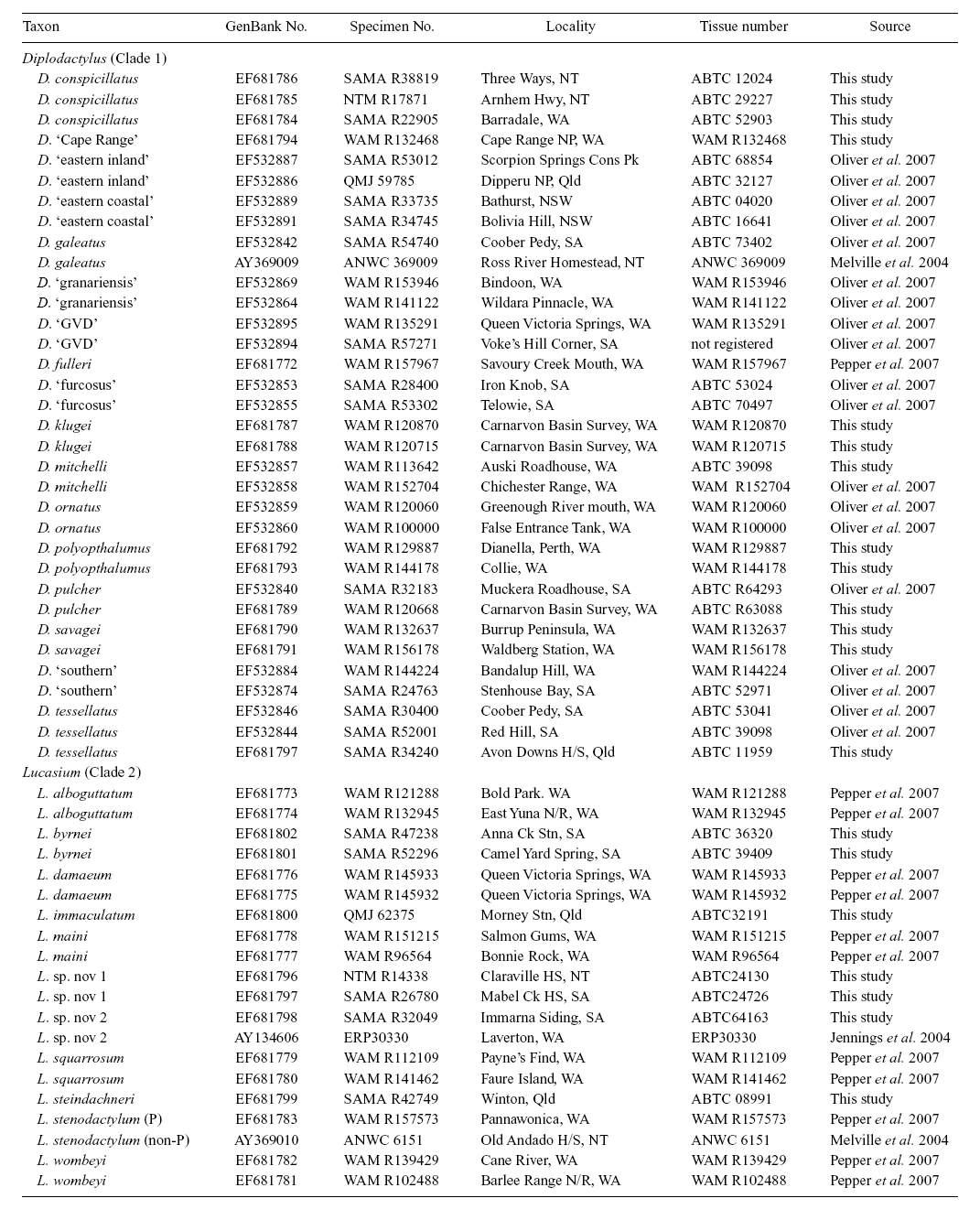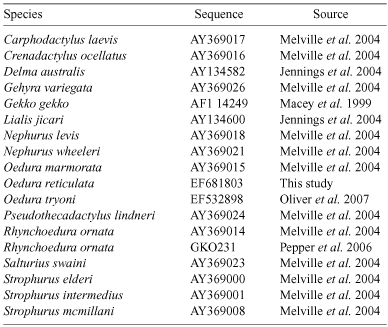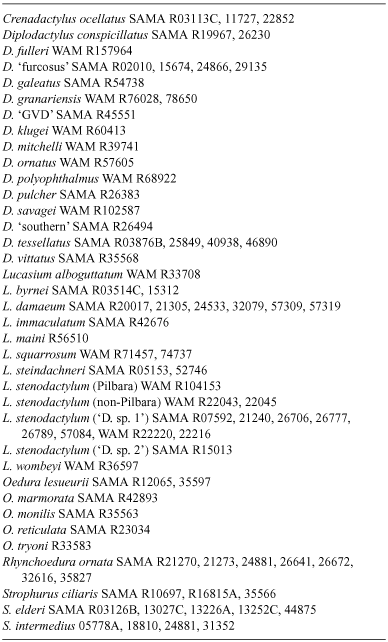Phylogenetic relationships in the lizard genus Diplodactylus Gray and resurrection of Lucasium Wermuth (Gekkota, Diplodactylidae)
Paul M. Oliver A B D , Mark N. Hutchinson A B and Steven J. B. Cooper A CA South Australian Museum, Adelaide, SA 5000, Australia.
B School of Earth and Environmental Sciences, University of Adelaide, SA 5005, Australia.
C Australian Centre for Evolutionary Biology and Biodiversity, The University of Adelaide, SA 5005, Australia.
D Corresponding author. Email: paul.oliver@adelaide.edu.au
Australian Journal of Zoology 55(3) 197-210 https://doi.org/10.1071/ZO07008
Submitted: 8 February 2006 Accepted: 24 May 2007 Published: 28 June 2007
Abstract
Diplodactylid geckos offer a model system for investigating the biogeographic history of Australia and adaptive radiations in the arid zone, but there is considerable uncertainty in the systematics of several key genera. We used sequence data from mitochondrial DNA to carry out a comprehensive analysis of phylogenetic relationships of geckos in the genus Diplodactylus. Parsimony and Bayesian analyses were highly concordant and allocated all species to one of two monophyletic clades, one comprising the species placed in the vittatus and conspicillatus species groups, the other comprising species placed in the stenodactylus and steindachneri species groups, plus D. byrnei, formerly in the vittatus group. The distinctness of these two clades is supported by external morphology of the digits, body and limb proportions, and osteology of the bones in the orbital region, and we use these characters to formally define the two clades as genera. We revive and expand the genus Lucasium for D. byrnei, D. steindachneri and the stenodactylus group, with the other species staying in a redefined Diplodactylus. The monotypic Rhynchoedura is distinct from Lucasium, although the Bayesian mtDNA analysis (but not parsimony) gives some support for a sister-group relationship between Lucasium and Rhynchoedura. Molecular data suggest that each of these clades represents a distinct radiation into semiarid and arid terrestrial habitats during the mid-Tertiary, well before the hypothesised Pliocene onset of major aridification.
Acknowledgements
We thank Paul Doughty, Brad Maryan, Scott Keogh, Mitzy Pepper and Paul Horner for access to data and specimens; Adam Skinner, Mike Lee and Andrew Hugall for their generous assistance with analysis and technical support; and Kathy Saint, Leanne Wheaton and Terry Bertozzi for assistance with laboratory work. This work was supported by grants from the Australia Pacific Science Foundation, Mark Mitchell Foundation and Australian Biological Resources Study. All South Australian Museum and University of Adelaide animal research is carried out under the supervision of the Wildlife and University of Adelaide (respectively) Animal Experimentation Ethics Committees.
Alley, N. F. (1998). Cainozoic stratigraphy, palaeoenvironments and geological evolution of the Lake Eyre Basin. Palaeogeography, Palaeoclimatology, Palaeoecology 144, 239–263.
| Crossref | GoogleScholarGoogle Scholar |
Donnellan, S. C. , Hutchinson, M. N. , and Saint, K. M. (1999). Molecular evidence for the phylogeny of Australian gekkonoid lizards. Biological Journal of the Linnean Society 67, 97–118.
| Crossref | GoogleScholarGoogle Scholar |
Fujioka, T. , Chappell, J. , Honda, M. , Yatsevich, I. , Fifield, K. , and Fabel, D. (2005). Global cooling initiated stony deserts in central Australia 2–4 Ma, dated by cosmogenic 21Ne–10Be. Geology 33, 993–996.
| Crossref | GoogleScholarGoogle Scholar |
Han, D. , Zhou, K. , and Bauer, A. M. (2004). Phylogenetic relationships among gekkotan lizards inferred from C-mos nuclear DNA sequences and a new classification of the Gekkota. Biological Journal of the Linnean Society 83, 353–368.
| Crossref | GoogleScholarGoogle Scholar |
Oliver, P. , Hugall, A. , Adams, M. , Cooper, S. J. B. , and Hutchinson, M. (2007). Genetic elucidation of ancient and cryptic diversity in a group of Australian geckos: the Diplodactylus vittatus complex. Molecular Phylogenetics and Evolution 44, 77–88.
| Crossref | GoogleScholarGoogle Scholar | PubMed |
Pianka, E. R. , and Pianka, H. D. (1976). Comparative ecology of twelve species of nocturnal lizards (Gekkonidae) in the Western Australian desert. Copeia 1976, 125–142.
| Crossref | GoogleScholarGoogle Scholar |
Russell, A. P. (1979). Parallelism and integrated design in the foot structure of gekkonine and diplodactyline geckos. Copeia 1979, 1–21.
| Crossref | GoogleScholarGoogle Scholar |
Zaaf, A. , and Van Damme, R. (2001). Limb proportions in climbing and ground-dwelling geckos (Lepidosauria, Gekkonidae): a phylogenetically informed analysis. Zoomorphology 121, 45–53.
| Crossref | GoogleScholarGoogle Scholar |


|

|

|


